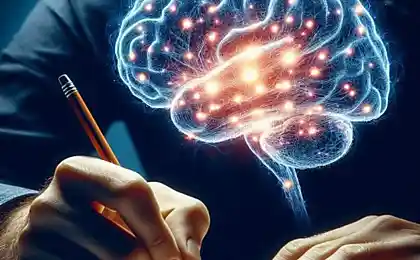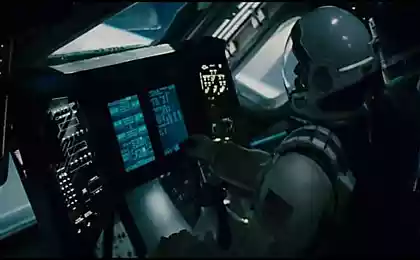395
I move your hand: how to develop the technology of telepathy
Sixty one million five hundred fifty nine thousand one hundred seventy six
istockphoto.com
Telepathy always seemed to us the ability of science fiction. But today, experts from the field of neuroscience and robotics is already conducting experiments that allow the person with the power of thought to control the rat tail, alien limb, or to convey words to another country. Interesting material on this subject was recently published on the website of The Conversation.
Control rat gostosa the last two years, scientists from different countries conducted several studies, which prove that the interaction "from-brain-to-brain" (brain-to-brain interface, or BBIs) is not science fiction but a very real thing. Contact only due to the activity of the brain was observed in two animals, two people and even in humans and lab rats.
In 2013, a team of specialists from the University of Washington (USA) have managed to create for the first time to test the method of telepathy. In the experiment, they used the technology of electroencephalography (EEG), which record the electrical signals of the brain, and the method of transcranial magnetic stimulation (TMS), allows you to selectively increase the activity of the cortex without penetration, using short magnetic pulses. In the study, two people had together to win in a computer game — just look at each other and exchange verbal messages and signs was impossible. Instead, the first party — the sender — had to visualize where you want to move the cursor. Electroencephalograph recorded this signal and transmit it via the Internet to the TMS machine. This device stimulated areas of the cerebral cortex "recipient", "sender" could to get him the desired motion of the fingers.
Specialists from Korea University (South Korea) and Boston University (USA) used other technologies: transcranial focused ultrasound (transcranial focused ultrasound, or FUS) is capable of without surgical intervention to modulate neural activity in the right areas, and the interface for translating electrical impulses of the brain into computer commands. This allowed the tests to establish a link between the human brain and the brain of laboratory rats. The experimental participant was looking at the light spot on the monitor, imagining where it should go. Interface translated the signal into a computer language and redirected it to the FUS device. Using the ultrasound signal delivered to the site of a rat's brain responsible for the movement of her tail. As a result, the tail moved to where I was mentally directing his people.
How it works
How is the process of transferring data from the brain to the device and from the device to the brain? This is possible due to the ability of neurons to send each other signals by synaptic transmission — the process of movement between nerve cells chemicals that cause them flashes of electrical activity. Synaptic transmission is the basis of the whole mechanism of the neural tissue. Memory, motor skills, emotions, cognitive skills — everything depends on it. Brain cells are connected to each other, so lots of little electric flashes gives a well-oiled pulsating electrical activity — the so-called brain waves.
To record brain waves EEG allows. Depending on what the brain, they can look very different: for example, in REM sleep the tape record is full of sharp peaks and deep dips, but the slow-wave sleep brain waves more closely resemble a smooth sinusoid. The data obtained during EEG can be transformed into computer commands. Such "translation" is already used in medicine: for example, it allows you to make neural prosthesis — a small device to support and restore brain function. These include, in particular, cochlear implants — devices to improve hearing, one part of which is implanted into the inner ear and the other attached to the hair or scalp. Such devices are made for people with sensorineural hearing loss (caused by damage to the organs of the inner ear, auditory nerve or centre in the brain), for whom hearing AIDS.
Four million five hundred ninety four thousand six hundred nineteen
interaction "from-brain-to-brain" between two people
The "electric" nature of the brain allows us not only to send but also to receive signals. This can be done using machines transcranial magnetic stimulation (TMS). Such devices create around the head magnetic field, allowing surgical intervention to increase the electrical activity of the brain areas beneath them. Yet in the studies it usually is about the areas associated with motor skills. TMS can stimulate the movement of the hands, feet, or even one finger. Now scientists are working to create devices that can "filter out" General "noise" of brain waves, so that the apparatus of TMS will be able to find and pass only the desired signals. This will create an artificial channel of communication in the field of movements — first, between animals in the laboratory.
Successful experiments that are not associated with motility, have also been conducted. In August 2014, the specialists of the company-developer of robots Axilum Robotics (Strasbourg, France) and neuroscientists from the University of Barcelona for the first time managed to achieve a conscious telepathic transmission of thoughts between two people. They used EEG and TMS; however, the "sender" was in India, and "recipient" in France. Scholars translated words in binary code: the Spanish "hola" is equal to 1, and the Italian "ciao" is 0. Indian "sender" is thinking about one of these words, the EEG machine passed electrical signal, the encoding, then the message is accepted the apparatus of TMS, which is located above the visual area of the cerebral cortex is the "beneficiary". As a result, people in France saw the flash of light, like a beacon, and knowing the code could translate them back into words: "hola" or "ciao".
Eighty nine million five hundred ninety thousand six hundred seventy six
conscious telepathic transmission of thoughts between two people
This prototype "brain-Telegraph" while it is impossible to use anywhere but the invention has great potential. Its application is possible, for example, within psychotherapy, including cognitive behavioral therapy, in the process of learning new or lost motor skills in the field of robotic research and explore remote places on Earth, Mars and other planets.
Development can even give rise to a new profession — neurocristopathy. The specialists of this region, in theory, will deal with encryption and the creation of codes suitable for the human brain, and perhaps based on a simple visual characters of the Morse code short and long flashes of light. Now this prospect, of course, seems fantastic. But it is worth remembering that the British cryptographer Alan Turing created one of the first in the history of the computer models — a revolutionary device to crack the German Enigma code — less than 80 years ago.published
P. S. And remember, only by changing their consumption — together we change the world! ©
Source: theoryandpractice.ru
istockphoto.com
Telepathy always seemed to us the ability of science fiction. But today, experts from the field of neuroscience and robotics is already conducting experiments that allow the person with the power of thought to control the rat tail, alien limb, or to convey words to another country. Interesting material on this subject was recently published on the website of The Conversation.
Control rat gostosa the last two years, scientists from different countries conducted several studies, which prove that the interaction "from-brain-to-brain" (brain-to-brain interface, or BBIs) is not science fiction but a very real thing. Contact only due to the activity of the brain was observed in two animals, two people and even in humans and lab rats.
In 2013, a team of specialists from the University of Washington (USA) have managed to create for the first time to test the method of telepathy. In the experiment, they used the technology of electroencephalography (EEG), which record the electrical signals of the brain, and the method of transcranial magnetic stimulation (TMS), allows you to selectively increase the activity of the cortex without penetration, using short magnetic pulses. In the study, two people had together to win in a computer game — just look at each other and exchange verbal messages and signs was impossible. Instead, the first party — the sender — had to visualize where you want to move the cursor. Electroencephalograph recorded this signal and transmit it via the Internet to the TMS machine. This device stimulated areas of the cerebral cortex "recipient", "sender" could to get him the desired motion of the fingers.
Specialists from Korea University (South Korea) and Boston University (USA) used other technologies: transcranial focused ultrasound (transcranial focused ultrasound, or FUS) is capable of without surgical intervention to modulate neural activity in the right areas, and the interface for translating electrical impulses of the brain into computer commands. This allowed the tests to establish a link between the human brain and the brain of laboratory rats. The experimental participant was looking at the light spot on the monitor, imagining where it should go. Interface translated the signal into a computer language and redirected it to the FUS device. Using the ultrasound signal delivered to the site of a rat's brain responsible for the movement of her tail. As a result, the tail moved to where I was mentally directing his people.
How it works
How is the process of transferring data from the brain to the device and from the device to the brain? This is possible due to the ability of neurons to send each other signals by synaptic transmission — the process of movement between nerve cells chemicals that cause them flashes of electrical activity. Synaptic transmission is the basis of the whole mechanism of the neural tissue. Memory, motor skills, emotions, cognitive skills — everything depends on it. Brain cells are connected to each other, so lots of little electric flashes gives a well-oiled pulsating electrical activity — the so-called brain waves.
To record brain waves EEG allows. Depending on what the brain, they can look very different: for example, in REM sleep the tape record is full of sharp peaks and deep dips, but the slow-wave sleep brain waves more closely resemble a smooth sinusoid. The data obtained during EEG can be transformed into computer commands. Such "translation" is already used in medicine: for example, it allows you to make neural prosthesis — a small device to support and restore brain function. These include, in particular, cochlear implants — devices to improve hearing, one part of which is implanted into the inner ear and the other attached to the hair or scalp. Such devices are made for people with sensorineural hearing loss (caused by damage to the organs of the inner ear, auditory nerve or centre in the brain), for whom hearing AIDS.
Four million five hundred ninety four thousand six hundred nineteen
interaction "from-brain-to-brain" between two people
The "electric" nature of the brain allows us not only to send but also to receive signals. This can be done using machines transcranial magnetic stimulation (TMS). Such devices create around the head magnetic field, allowing surgical intervention to increase the electrical activity of the brain areas beneath them. Yet in the studies it usually is about the areas associated with motor skills. TMS can stimulate the movement of the hands, feet, or even one finger. Now scientists are working to create devices that can "filter out" General "noise" of brain waves, so that the apparatus of TMS will be able to find and pass only the desired signals. This will create an artificial channel of communication in the field of movements — first, between animals in the laboratory.
Successful experiments that are not associated with motility, have also been conducted. In August 2014, the specialists of the company-developer of robots Axilum Robotics (Strasbourg, France) and neuroscientists from the University of Barcelona for the first time managed to achieve a conscious telepathic transmission of thoughts between two people. They used EEG and TMS; however, the "sender" was in India, and "recipient" in France. Scholars translated words in binary code: the Spanish "hola" is equal to 1, and the Italian "ciao" is 0. Indian "sender" is thinking about one of these words, the EEG machine passed electrical signal, the encoding, then the message is accepted the apparatus of TMS, which is located above the visual area of the cerebral cortex is the "beneficiary". As a result, people in France saw the flash of light, like a beacon, and knowing the code could translate them back into words: "hola" or "ciao".
Eighty nine million five hundred ninety thousand six hundred seventy six
conscious telepathic transmission of thoughts between two people
This prototype "brain-Telegraph" while it is impossible to use anywhere but the invention has great potential. Its application is possible, for example, within psychotherapy, including cognitive behavioral therapy, in the process of learning new or lost motor skills in the field of robotic research and explore remote places on Earth, Mars and other planets.
Development can even give rise to a new profession — neurocristopathy. The specialists of this region, in theory, will deal with encryption and the creation of codes suitable for the human brain, and perhaps based on a simple visual characters of the Morse code short and long flashes of light. Now this prospect, of course, seems fantastic. But it is worth remembering that the British cryptographer Alan Turing created one of the first in the history of the computer models — a revolutionary device to crack the German Enigma code — less than 80 years ago.published
P. S. And remember, only by changing their consumption — together we change the world! ©
Source: theoryandpractice.ru
11 amazing facts about the daily life of Swiss
10 ways the original design of the Windows in the interior























